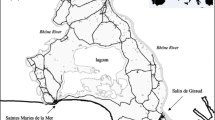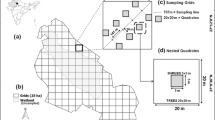Abstract
The invasive non-native shrub Rosa rugosa (Japanese Rose) is well-established in many northwest European countries where, especially on coastal sand-dunes, it forms large dominant stands with adverse effects on semi-natural vegetation and biota of high conservation status. Its recent increase in England’s largest dune system on the Sefton Coast in north Merseyside led to an investigation into its rate of spread. Using digitised aerial photographs and GIS methodology, sample patches of old-established R. rugosa were found to have grown in area by an average of 22 % per annum between 1989 and 2013. This rate of increase is comparable to that found in Denmark and higher than reported for several other woody plants in coastal dunes. In the absence of management, R. rugosa could soon dominate large areas on the Sefton Coast, with serious consequences for amenity and the nature conservation interest of the dune system.



Similar content being viewed by others
References
Boardman C (2014) A GIS study of the spread of Rosa rugosa and its effects within two sample sites in Birkdale Sandhills LNR, Sefton Coast. B.Sc. dissertation, School of Health Sciences, Liverpool Hope University
Braithwaite ME, Ellis RW, Preston CD (2006) Change in the British flora 1987–2004. Botanical Society of the British Isles, London
Bruun HH (2005) Rosa rugosa Thunb. Ex Murray. J Ecol 93:441–470
Clarke D, Sanitwong Na Ayutthaya S (2010) Predicted effects of climate change, vegetation and tree cover on dune slack habitats. J Coast Conserv 14:115–125
Davies A, Waite S (1998) The persistence of calcareous grassland species in the soil seed bank under developing and established scrub. Plant Ecol 136:27–39
Doody JP (2013) Sand dune conservation, management and restoration. Springer, Dordrecht
Edmondson SE (2010) Non-native plants on the Sefton Coast sand-dunes. In: Worsley AT, Lymbery G, Holden VJC, Newton M (eds) Sefton’s dynamic coast. Sefton Technical Services Department, Southport, pp. 201–213
Edmondson SE, Gateley PS, Nissenbaum DA (1988/89) National sand dune vegetation survey: the Sefton Coast. Report no. 917. Nature Conservancy Council, Peterborough
Edwards C (2006) Managing and controlling invasive rhododendron. Forestry Commission, Edinburgh
Fuller RM, Boorman LA (1977) The spread and development of Rhododendron ponticum L. on dunes at Winterton, Norfolk, in comparison with invasion by Hippophaë rhamnoides L. at Saltfleetby, Lincolnshire. Biol Conserv 12:83–94
Gateley PS, Michell PE (2004) Sand Dune Survey of the Sefton Coast. Report by TEP, Warrington, to Sefton Metropolitan Borough Council, Bootle
Hill N, Beveridge L, Flynn A, Garbary D (2010) Rosa rugosa as an invader of coastal sand dunes of Cape Breton Island and the mainland of Nova Scotia. Can Field Nat 124:151–124
Hipkin C (2003) Putting our alien flora in perspective. Br Wildl 14:413–422
Hodgkin SE (1984) Scrub encroachment and its effect on soil fertility on Newborough Warren, Anglesey, Wales. Biol Conserv 29:99–119
Isermann M (2008) Expansion of Rosa rugosa and Hippophae rhamnoides in coastal grey dunes: effects at different special scales. Flora 203:273–280
Joint Nature Conservation Committee (2004) Common standards monitoring guidance for sand dune habitats. Version August 2004. JNCC, Peterborough
Jørgensen RH, Kollmann J (2009) Invasion of coastal dunes by the alien shrub Rosa rugosa is associated with roads, tracks and houses. Flora 204:289–297
Kollmann J, Jørgensen RH, Roelsgaard J, Skove-Petersen H (2009) Establishment and clonal spread of the alien shrub Rosa rugosa in coastal dunes. A method for reconstructing and predicting invasion patterns. Landsc Urban Plan 93:194–200
Maskew R (2002) Rosa rugosa Japanese Rose. In: CD Preston, DA Pearman, TD Dines (eds) New atlas of the British and Irish flora. Oxford University Press, Oxford, p. 346
Packham JR, Willis AJ (1997) Ecology of dunes salt marsh and shingle. Chapman & Hall, London
Pearman D, Walker K (2009) Alien plants in Britain: a real or imagined problem. Br Wildl 21:22–27
Rhind PM, Jones PS (1999) The floristics and conservation status of sand-dune communities in Wales. J Coast Conserv 5:31–42
Richards EG, Burningham H (2011) Hippophae rhamnoides on a coastal dune system: a thorny issue? J Coast Conserv 15:73–85
Richardson DM, Pyšek P, Rejmánek M, Barbour MG, Penetta FD, West CJ (2000) Naturalisation and invasion of alien plants: concepts and definitions. Divers Distrib 6:93–107
Rodwell JS (ed) (2000) British plant communities volume 5. Maritime communities and vegetation of open habitats. Cambridge University Press, Cambridge
Savidge JP, Heywood VH, Gordon V (eds) (1963) Travis’s flora of South Lancashire. Liverpool Botanical Society, Liverpool
Simberloff D (2005) Non-native species do threaten the natural environment! J Agric Environ Ethics 18:595–607
Simpson D, Houston J, Rooney PJ (2001) Towards best practice in the sustainable management of sand dune habitats: 2. Management of the Ainsdale dunes on the Sefton Coast. In: JA Houston, SE Edmondson, PJ Rooney (eds) Coastal dune management. Shared experience of European conservation practice. Liverpool University Press, Liverpool, pp. 262–270
Smith PH (2009) The sands of time revisited: an introduction to the sand-dunes of the Sefton coast. Amberley Publishing, Stroud
Smith PH, Deed B (2014) A volunteer survey of Japanese Rose (Rosa rugosa) on the Sefton Coast, Merseyside. Merseyside BioBank, Court Hey Park, Liverpool
Smith PH, Kimpton A (2008) Effects of grey willow Salix cinerea removal on the floristic diversity of a wet dune-slack at Cabin Hill National Nature Reserve on the Sefton Coast, England. Conserv Evid 5:6–11
Stace CA, Crawley MJ (2015) Alien plants. Collins New Naturalist, London
Theoharides KA, Dukes JS (2007) Plant invasion across space and time: factors affecting non-indigenous species success during four stages of invasion. New Phytol 176:256–273
Weidema I (2006) NOBANIS – invasive alien species fact sheet – Rosa rugosa. www.nobanis.org accessed 10th March 2015
Williamson M (1996) Biological invasions. Chapman & Hall, London
Acknowledgments
This study formed a component of a B.Sc. Degree in the School of Health Sciences, Liverpool Hope University. Thanks are due to Dr. Barbara Tigar for supervising the project and to Dave Mercer, Rachel Northover and Sally Edmondson and staff of the Geography Department for help, support and advice. Hollie Armstrong and Matthew Rogan assisted with field work. Ben Deed and the volunteers at Merseyside BioBank kindly provided access to aerial photographs and GIS software and also gave advice on data analysis. We are most grateful to Maike Isermann for helpful comments and for providing relevant literature and to Richard Burkmar for statistical advice.
Author information
Authors and Affiliations
Corresponding author
Rights and permissions
About this article
Cite this article
Boardman, C., Smith, P.H. Rates of spread of Rosa rugosa (Japanese Rose) determined by GIS on a coastal sand-dune system in Northwest England. J Coast Conserv 20, 281–287 (2016). https://doi.org/10.1007/s11852-016-0439-7
Received:
Revised:
Accepted:
Published:
Issue Date:
DOI: https://doi.org/10.1007/s11852-016-0439-7




